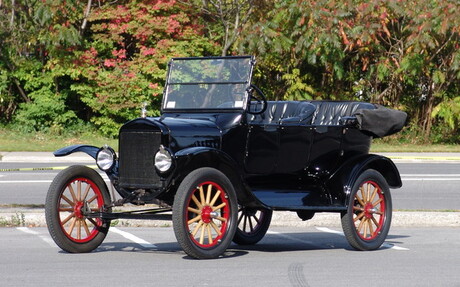The Ford Model T: A technological breakthrough
The automobile. An everyday object of consumption. These days, knowing how to drive is almost as essential as knowing how to walk. In fact, all too often we find ourselves taking the car instead going by foot. The Car, with a capital C, has shaped our lives, our environment, our identity. And one of the key players behind the popularization of the automobile is the Ford Model T.
Last year, to celebrate the 100th anniversary of the car that literally got America – and much of the world – on wheels, Ford Canada invited journalists to come take it for a spin. Also present was Mr. Gérard Moisan, the guy who could also be called "Quebec’s Mr. Model T." He came with three of his vehicles to show us how to drive his T 1921.
But first, a look back on history. More than 15 million Model Ts were made and sold from 1908 to 1927. And although this car is considered by many to be the origin of the assembly line, that belief is not entirely true. In fact, the assembly line already existed, but Henry Ford, who was always looking to increase productivity and profitability, refined the process to an all-new level of efficiency. In 1908, a T could be assembled in 12.5 hours. By 1914, that time was reduced to 1.5 hours! Contrary to popular belief, not all Model Ts were black. From 1908-1913 and 1926-1927, it was offered in different colours.
Black was used the most, however, because it dried quickly and therefore did not slow production. The fact that it was cheap probably factored in there too... And what about the Model T’s ever-decreasing price (from $825 in 1908 to $206 in 1926)? No Mother Teresa syndrome there. Henry Ford knew very well that the more affordable his vehicles were, the more he would sell and the more money he would pocket!
Over the years, the Model T underwent very few changes as Henry Ford was strictly against modifying his winning recipe. Plus, old Henry was never really one to compromise... Despite that, the headlights were changed from acetylene lamps to electric lights in 1915, and other cosmetic changes were introduced between 1917 and 1923. Finally, the electric starter was first offered in 1919 and became standard in 1926.
So, what’s so special about driving a Model T?
This vehicle has often been called the "Ford pedal car," and with good reason. Driving a Model T requires as much footwork as use of the steering wheel. It comes with three foot pedals, though none has the same functions as today’s. The right pedal is not the accelerator, it’s the brake (the accelerator is on the steering wheel). The middle pedal was used to engage reverse gear, while the left pedal was to shift gears. Press it all the way in to put the car into first, release it to shift into second. Neutral is half-way between the two. The first time I wanted to slow this car down, I naturally put my foot sturdily into the left pedal, as I would on a modern vehicle. The T, now in first gear, bucked and lunged dangerously at the curb. Luckily, the courageous Mr. Moisan stepped in. Despite that episode, it’s really no harder to drive a Model T than it is to program an address into a GPS. One requires mechanical skill, the other electronic. It’s just a matter of getting used to it.
I could spend half this text describing what it’s like to drive a Ford Model T, but you can actually recreate the feeling yourself. To find out what it’s like to drive a Model T – or most any of the cars from the 1910s and 20s – simply take your car, place a wood plank on the seat and another on the seat back. There you have the seat of a T. Then remove the side windows, the rear window and the roof. Do away with the heating and air con. Get rid of the radio, seat belts, air bags and anything else that could be considered superfluous, including the starter and fuel pump. To get the lighting right, coat 90% of the lighting surfaces with black paint. As for the mechanics, it’s not complicated. Place a piece of wood under the accelerator and block all the gears above second. Change the steering ratio so that taking corners requires turning the wheel twice as much as usual and so that driving straight can only be accomplished with frequent corrections. Remove the oil from the brake servo unit – you know, just so you can roughly replicate how it feels to brake in a Model T. And for full effect, get out and change a tire every 30 or 40 km, because in that era horseshoes left nails behind, ready to puncture the delicate rubber of the tires. (I owe this comparison to Gilbert Bureau who wrote something similar in this outstanding magazine, Auto Ancienne.)
A time for everything and History will be preserved
So, you think driving the T would be horrendous? Well, yeah, it would seem that way in today’s context. But at the turn of the last century, it was a technological breakthrough. Personally, I’d like to live another 100 years, just to see what they’ll be saying about the 2010 Ford Flex, for example... "Take your FoTo (the brand created when Ford bought out the failing Toyota company in 2061), remove the HCASS (Human Cerebral Activity Scanning System) and replace it with an archaic voice-activated GPS system. The nuclear microfibre seats with wave suspension should be replaced with shoddy leather seats. Reduce your engine power by 90% and increase your CO2 emissions by 90%..."
